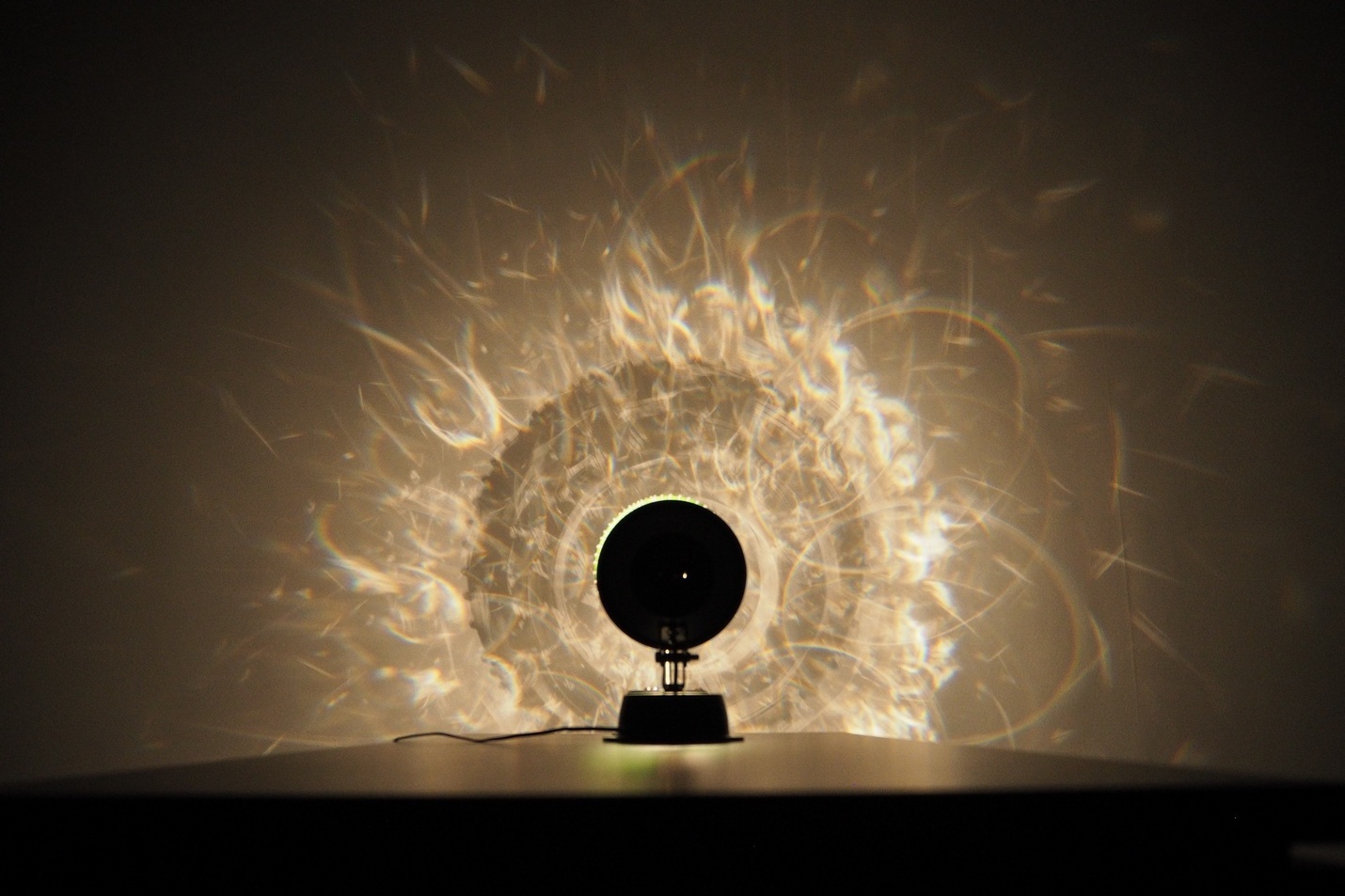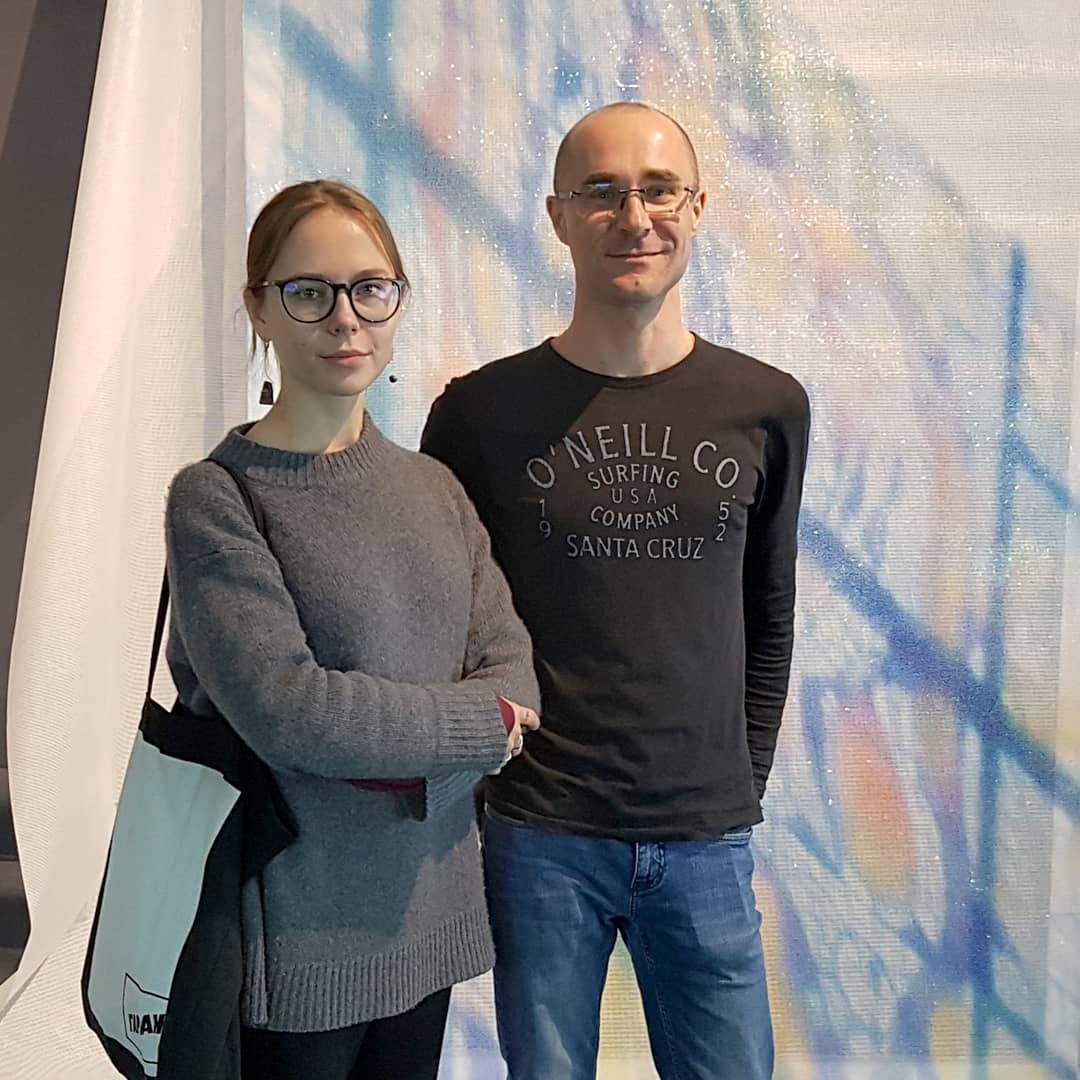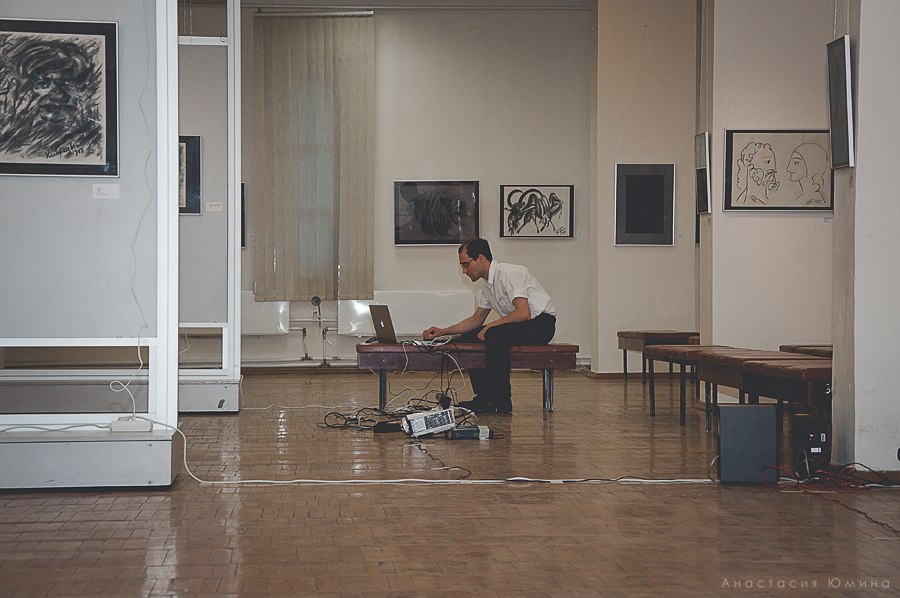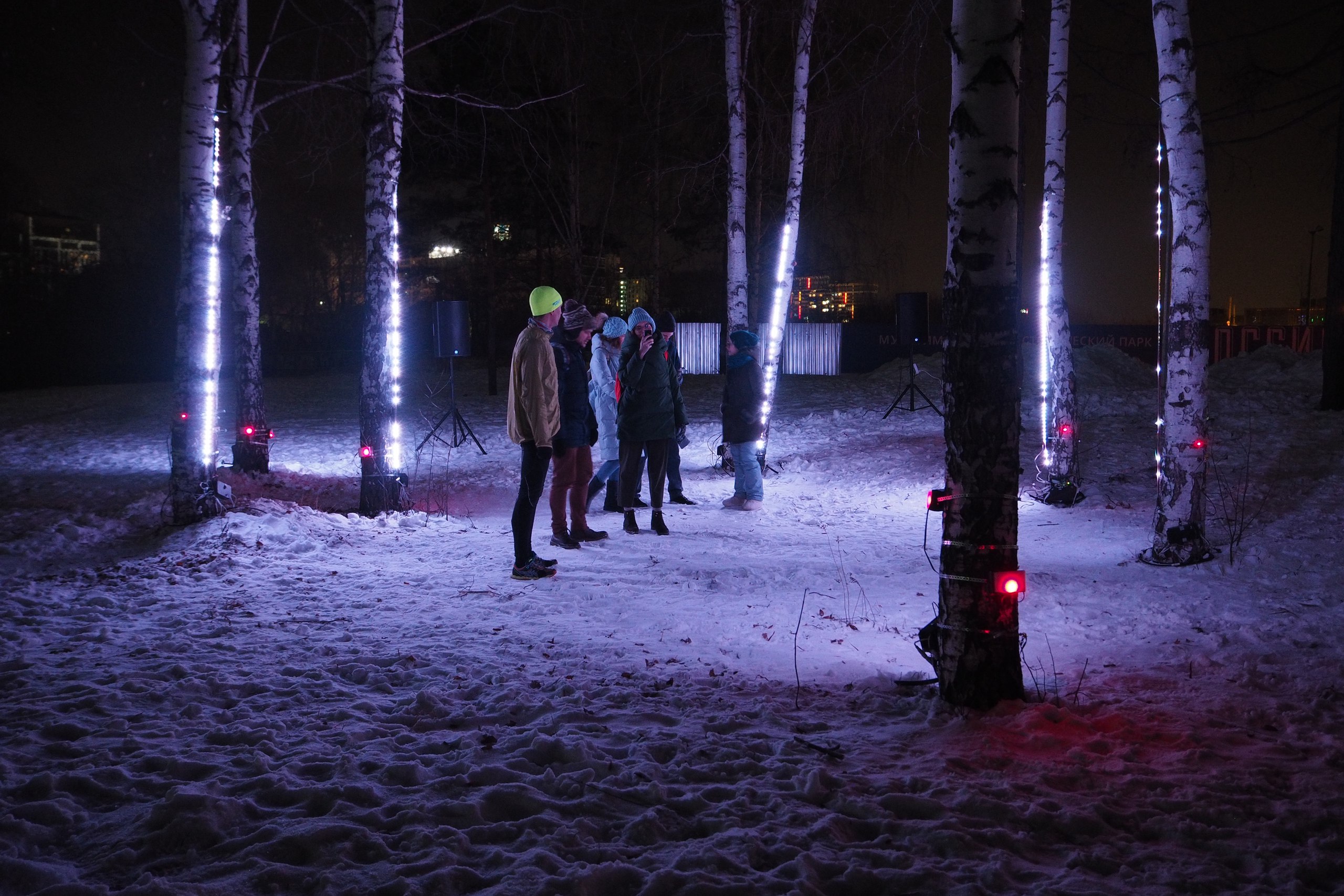Hakspeys, Denis Perevalov, Anastasia Krokhaleva - the magic of programming

What attracts us to magic? This is something beyond our understanding, something interesting, something unusual. And programming to some extent is magic. And there are wizards in programming who, with the help of electronics / programming, do some unimaginable and original things - that take us beyond the ordinary, into an unusual world.
We continue a series of publications on the topic “Hackspace with a human face”, where we present interviews with participants of our Hackspace MakeItLab in Yekaterinburg. Last time we talked about Stepan Glushko (ornithopters) .
')
This time the interview will be with Denis Perevalov (a software mathematician, media artist) and Anastasia Krokhaleva (master of art history, media artist).
Denis develops interactive installations (based on light effects, electronics / robotics, OpenCV visual processing, neural networks, etc.), implements his ideas and helps in the implementation of ideas of creative people. In particular, it uses the openFrameworks framework, about which there was a small tutorial . In addition, he is the author of the openFrameworks book, and lectures on machine learning (deep learning).
Since 2017, Denis and Anastasia have worked together as an art duet " Museum of eternally playing attractions ." Create interactive light and sound installations.
Yes, and on KDPV - the Microcosmos project ...
An interview with Denis and Anastasia was helped by Ekaterina (the editor of the congenial project “Innovator” - the community of makers), she was told:
If the goal is to find the nerve of modernity ...

Anastasia Krokhaleva and Denis Perevalov
Let's start from afar. What season do you like?
Denis: Probably, even the most important thing is not any particular time of year, but changes, transitions in any time period from one state to another. It is changes in nature that I like.
Anastasia: If we talk about nature, then I am more concerned not with simple observation, but with environmental problems and our participation or ignoring of these processes.
What do you charge in nature?
D. I love pine trees ...
A. And I am mushrooms - they are so strange in structure and character. And when you touch honeysuckle, there is a trace of fingers on it. It's funny. But I don’t charge it, I’m quite consumer in nature - I have everything to do with food.
Denis, do you like nature, and why do you prefer the “artificially created worlds”?
D. Nature is a given. I try to expand the boundaries of perception and understanding, give a different reading, emphasize certain sacraments, emphasize global issues. In general, I think that in nature everything is already created and nothing new can be created. But man is the creation of nature. He is its continuation. And with the development of civilization, it is transformed. Here I show these processes. "Development in the medium". This may be an electronic, virtual world, the world of human-conscious artifacts. Nature, but not nature, but artificial.
It turns out that Denis is a “technical romantic”, and Nastya is an “artistic realist”. Do you harmoniously complement each other?

Denis Perevalov
D. We, as artists, have already worked for several years, each independently. But I'm still more technical. I am able to create electronic things, and Nastya creates concepts that are linked to world problems. And just in this creation of opposites is our main strength and specificity. We are very different - it is a fact.
A. When we started working as a duet, our borders expanded and opportunities increased. And although we have a different attitude towards life, we coincided in nature and professional purpose. Therefore, there appeared a common path along which we are successfully moving forward.
Tell us about your duet
D. Our duet is called the Museum of Ever-Playing Amusements . We create objects from the field of contemporary art, complemented by the latest technologies, but purposefully make them playable. We lay deep, sometimes even provocative meanings into each object. Therefore, it seems to the child that he understands everything, starting to interact with the object, and the adult, rather, on the contrary.
A. We are interested in working with interactivity. But when we began to exhibit in this format, some critics reproached us with the fact that the interactive is not art, but entertainment. After analyzing our work, we stopped at the fact that it is the interactive that provides special opportunities for understanding both the concept itself and art. If our works will be perceived as attractions - this is just a new field for discussion, which we decided to promote in our projects.
The museum is a familiar concept. Virtual is something new. Mb coming up with other spaces for the new? How old and new technologies are combined?
D. Our works are also exhibited in classical galleries, but we are also mastering new ones - urban and natural spaces. Performance, installations - this is what we are working on and embody with interest. We are looking for new forms and ways of filing.
A. By education I am a master of art history and for several years I have been working as an art-mediator. Here in Yekaterinburg, the Ural Industrial Biennale and Bazhov-Fest are held periodically, where artists must exhibit in non-exhibition spaces. These are not museums, but, for example, abandoned industrial buildings - and this is such a challenge for the curator and artists. It is more difficult here, since the space is more unpredictable, it can be interpreted in different ways for the visitor. In museums of classical art, everything is ready for exhibiting works, therefore even to a contemporary artist from the point of view of solving various kinds of exhibition tasks happens on such sites quite comfortably. For example, the Hermitage opens its halls to new art and, thanks to some kind of shock, the viewer manages to find new meanings. The Moscow Biennale was held in the Tretyakov Gallery on Krymsky Val ... It is very interesting for artists to open a new space of the museum, which is already saturated with classical art, to build modernity into accepted-constant constants.
Does music complement your work?

D. I started to study music before programming. The first thing I started programming was a synthesizer. We include sound art, sound things. I am now a senior lecturer at the Ural Conservatory. The sound is present in many of our works. We even create some objects just for the sake of sound. For us, the visual and the audiality are inseparable, complementary or independent. Such an experience for the viewer.
A. For me, the sound side of perception was closed before the meeting with Denis. I did not know how to approach her and did not see much sense in it. Now, when we began to work together, I really like the sound that appeared in our works.

Installation "Threshold between worlds"
D. We have an installation “ Threshold between Worlds ” - this is a small thicket where light pulsating bands are hung, and around this thicket there is a set of several stereo speakers. And it turns out that the viewer, entering the thicket, not only sees the pulsation, but also hears whispers around him. This turns the thicket into a certain sacred world. And in our most recent works, we often do not add sounds, but find pleasure in the sound of the mechanisms themselves. “ Mistress. Present days ”- the sound of the motors of three mechanical hands creates the desired sound design and atmosphere for the viewer:
Read more
The installation consists of three robotic arms holding glass crystals, three laser cannons and cabinets with a monitor.
Concept
In the tales of Pavel Petrovich Bazhov, there is always an interaction of two sides: a person who is eager to get what he wants, and an incomprehensible, other-worldly force possessing secret knowledge. This force takes various guises from Bazhov, among which the Mistress of the Copper Mountain is the most powerful. Today, according to the authors, artificial intelligence (AI) can act as such a force. As the masters of mining could not fully understand the nature and motives of the Mistress, so the users of new technologies are now only beginning to learn the possibilities of AI, which is gradually becoming the “master” of the new digital world.
Is artificial intelligence capable of thinking freely, beyond the categories predetermined by humans, and what will the person feel in this case when interacting with him? And if the AI is endowed with its own will, will it give a helping hand to people, or, nevertheless, the Hostess will not help Danilo Master create a stone flower?
The authors of the installation offer viewers to interact with artificial intelligence - the Mistress, who realizes her will with the help of robotic hands. By controlling the laser settings, viewers can try to get into the crystals that hold these hands. But only the Mistress decides who to help in this, and who does not.
Technical details
The installation consists of 15 LewanSoul LX-16A digital servomotors, three actuators, three analog motors, three optoresistors, 8 Arduino boards (4 Uno, 3 Nano, 1 Mega), three glass crystals and three green lasers.
The brushes were scanned and printed on a 3D printer, as well as other parts of the hands.
The software is written on openFrameworks, with external addons ofxKuTextGUI (GUI), ofxKu (utilities), ofxTSNE (implementation of the t-SNE algorithm). All calculations are performed on a Windows computer.
The installation consists of three robotic arms holding glass crystals, three laser cannons and cabinets with a monitor.
Concept
In the tales of Pavel Petrovich Bazhov, there is always an interaction of two sides: a person who is eager to get what he wants, and an incomprehensible, other-worldly force possessing secret knowledge. This force takes various guises from Bazhov, among which the Mistress of the Copper Mountain is the most powerful. Today, according to the authors, artificial intelligence (AI) can act as such a force. As the masters of mining could not fully understand the nature and motives of the Mistress, so the users of new technologies are now only beginning to learn the possibilities of AI, which is gradually becoming the “master” of the new digital world.
Is artificial intelligence capable of thinking freely, beyond the categories predetermined by humans, and what will the person feel in this case when interacting with him? And if the AI is endowed with its own will, will it give a helping hand to people, or, nevertheless, the Hostess will not help Danilo Master create a stone flower?
The authors of the installation offer viewers to interact with artificial intelligence - the Mistress, who realizes her will with the help of robotic hands. By controlling the laser settings, viewers can try to get into the crystals that hold these hands. But only the Mistress decides who to help in this, and who does not.
Technical details
The installation consists of 15 LewanSoul LX-16A digital servomotors, three actuators, three analog motors, three optoresistors, 8 Arduino boards (4 Uno, 3 Nano, 1 Mega), three glass crystals and three green lasers.
The brushes were scanned and printed on a 3D printer, as well as other parts of the hands.
The software is written on openFrameworks, with external addons ofxKuTextGUI (GUI), ofxKu (utilities), ofxTSNE (implementation of the t-SNE algorithm). All calculations are performed on a Windows computer.
Is there a concept of "competition" in your work?
Many authors and groups work in the direction of technological art. From the point of view of technology and concepts, of course, there are those who are close to us in spirit, those to whom we are oriented. Competition, as such, no. We have specificity. In programming and concepts. For example, a drone tied on a rope ...
A. How, for example, is the process. There is an idea. From it a concept is developed. And then - visualization. We are exploring what has already been done, what is being done. Most often, we understand that we are doing unique things. But the competition is and it is powerful, because now it is the vanguard of art.
D. We test technology for their “weirdness”. This is our, slightly maniacal goal - to apply technology non-standardly, immersing the viewer in a new environment for sensations. At the same time, having foreseen a system of interaction with this environment, so that each one has new sensations and new thoughts.

Can you say a few words about your old, but still interesting project “Stihomashina”?
D. This project I did with the poet Tanya Simply . In real time, the sound of speech was captured and presented in the form of loops, as is done in electronic music. It turned out to create instantly a musical background directly from the readable work. Thus, such a “techno-poetic composition” was born before our eyes. Especially well listened to psychedelic poetry.
Probably, it is interesting to meet high school students in time to be intrigued by programming, discover something new in the symbiosis of music and words, try yourself in poetry ... And does your audience include schoolchildren?
D. Rather, they are people 20-40 years old. Those who are interested in contemporary art. Sounds of poetry, for example, are more for lovers of soundtracks or electronic music. For the untrained spectator, they were very extravagant. To understand the technological experimental art requires special training, much wider school curriculum.
Is art a hobby for you?
D. No, this is the main thing. We just do not close ourselves - we consider other areas of activity as feeding with ideas, technologies, as an important experience. Much can be seen in business and commerce, not less - in the course of communication with students. Even when you write a textbook or a book - ordering knowledge, new concepts grow. Like-minded people, customers and fans also come from different areas.
A. In the first place we always have art. But when you participate in different projects, you become more viable, you develop objective principles and views.
D. But if you do the same thing for a long time, then you lose touch with people, their expectations, and with the boiling life of a large and different society. The world is multi-polar, and if you can visit its different poles - you should not neglect this. In my world there is art, commerce, teaching, music. And this is not to earn money, but to feel full-fledged in the daily cycle, to be "on the wave." In addition, we are a little more builders, researchers and analysts - we ourselves carry out installation of structures, we are ready to replace parts and materials, we are modeling alternative solutions.
Do you have free time?
A. We are fanatics. Why do we need free time if it can be spent on continuing work? :) This is for us the meaning of life.
In Yekaterinburg, a strong maker movement. Oleg Evsegneev, nemilya - MakeItLab hackspace. Do you collaborate in the field of engineering creativity?
D. We often see the leaders of the Yekaterinburg maker movement. We really need the help of hackspace, makerlab and we gratefully accept it. Of course, we can do everything ourselves, but projects are growing and growing, therefore, as our orders are interesting for the people from the hackspace, so for us - this is a significant support in creating installations.
A. For the artist, it is important to create some kind of infrastructure for reliable cooperation. Hackspace is our wonderful partner who understands and supports all our initiatives.
Does the world of contemporary art require more talent or scientific knowledge?
A. Art should be relevant. We must grope for the nerve of modernity. What is needed more for this - an artistic component or engineering thought is a difficult question. Rather, the overall high level of culture and education, and constantly growing.
D. The answer to this question is precisely that we work as a duet of a conceptual artist and software engineer.
The most touching / expensive project of your duet?
D. Of course, this is our first collaboration. Nastya had a light installation. I supplemented it with interactivity and sound. We showed “ Microcosmos ” in the Technopark of Yekaterinburg. And this is where our joint work began.
Read more about Microcosmos
Description
In the depths of the dark room stands the cabinet on which the lamp and filter are located. The light of the lamp passes through a rotating filter and leaves reflections on a nearby wall and a measured melodious sound is heard. When a person tries to approach the installation, the sound is transformed into a roar, and the lamp begins to flash.
Concept
The installation embodies the author's vision of a model of an ideal universe - a ball from a multitude of drops glowing from the inside. Every person in particular and the whole of humanity as a whole is involved in the constant movement of the Universe. We are not given to feel this, but only in moments of rare insights can we try to realize the eternal circulation of all that exists in the unknown black space of the Cosmos. Moreover, this movement does not stop with the onset of death, but only changes, takes a different form. And this image is constantly oscillating, multi-spatial ball, consisting of billions of sparkling particles, the authors tried to embody in his work, using a specially designed light filter.
Technical rider
The installation is a cabinet with a height and a length of 1 meter and a width of 50 cm. A lamp and a filter are installed on the cabinet. Outside the cabinet, there is an Asus Xtion depth camera and a speaker system. Inside the cabinet is a computer.

Description
In the depths of the dark room stands the cabinet on which the lamp and filter are located. The light of the lamp passes through a rotating filter and leaves reflections on a nearby wall and a measured melodious sound is heard. When a person tries to approach the installation, the sound is transformed into a roar, and the lamp begins to flash.
Concept
The installation embodies the author's vision of a model of an ideal universe - a ball from a multitude of drops glowing from the inside. Every person in particular and the whole of humanity as a whole is involved in the constant movement of the Universe. We are not given to feel this, but only in moments of rare insights can we try to realize the eternal circulation of all that exists in the unknown black space of the Cosmos. Moreover, this movement does not stop with the onset of death, but only changes, takes a different form. And this image is constantly oscillating, multi-spatial ball, consisting of billions of sparkling particles, the authors tried to embody in his work, using a specially designed light filter.
Technical rider
The installation is a cabinet with a height and a length of 1 meter and a width of 50 cm. A lamp and a filter are installed on the cabinet. Outside the cabinet, there is an Asus Xtion depth camera and a speaker system. Inside the cabinet is a computer.

A. This project has shown how powerful the combined efforts are.
D. Yes, “Microcosmos” against the background of today's projects is small and light. Now the volumes, sizes, quantity of electronics in our installations are growing and we hope that we give the viewer the opportunity to experience a new sensory experience.
May the energy and drive be with you! :) New projects and discoveries! Thanks for the chat.
PS: Thanks to Ekaterina Alekseeva for the interview, the Novator project.
More on projects Anastasia and Denis, on their website .
Source: https://habr.com/ru/post/430060/
All Articles